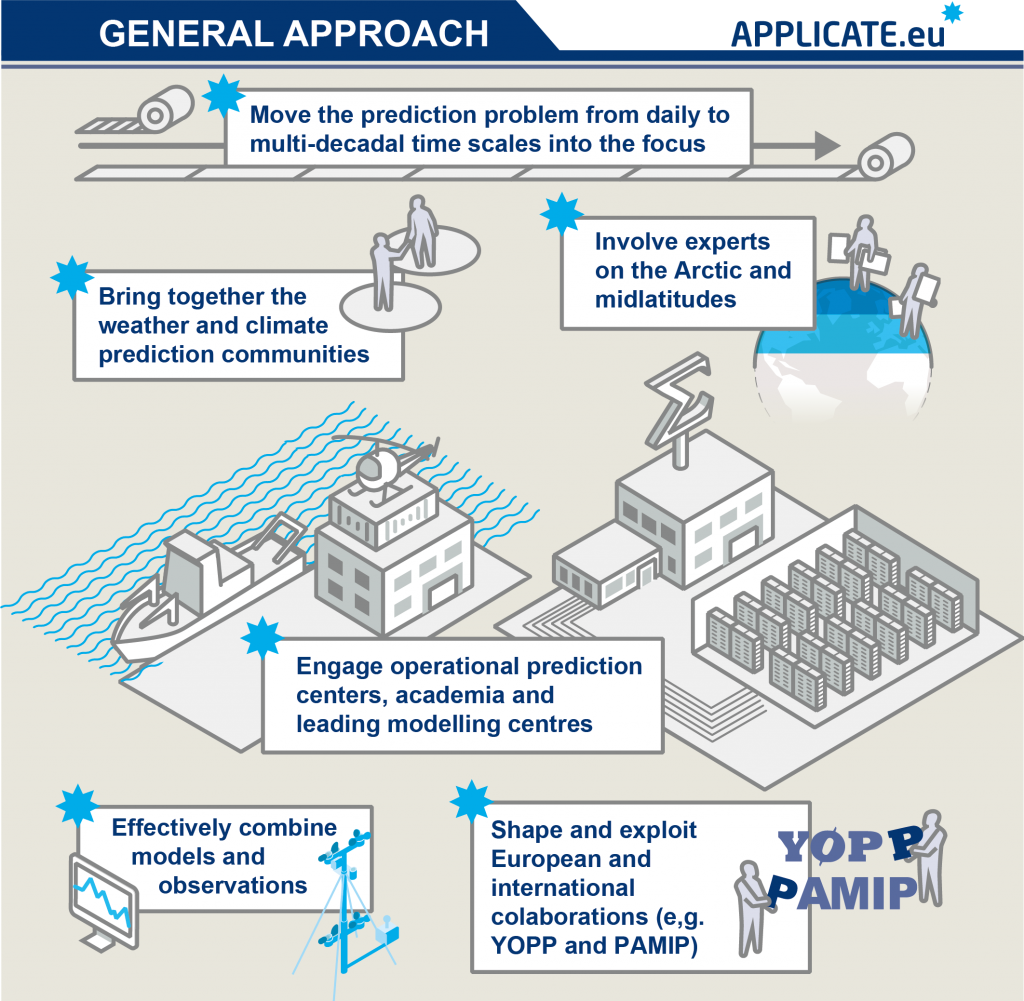About the project
 APPLICATE (Advanced Prediction in Polar regions and beyond: modelling, observing system design and LInkages associated with a Changing Arctic climaTE), an €8 million project financed by the EU HORIZON 2020 Research and Innovation programme, involves 15 partners from eight countries (Belgium, France, Germany, Norway, Russia, Spain, Sweden and the United Kingdom) and will be carried out over a period of four years.
APPLICATE (Advanced Prediction in Polar regions and beyond: modelling, observing system design and LInkages associated with a Changing Arctic climaTE), an €8 million project financed by the EU HORIZON 2020 Research and Innovation programme, involves 15 partners from eight countries (Belgium, France, Germany, Norway, Russia, Spain, Sweden and the United Kingdom) and will be carried out over a period of four years.
The multinational and multidisciplinary consortium works to enhance weather and climate prediction capabilities not only in the Arctic, but also in Europe, Asia, and North America.
A focus on the Arctic is important for improved predictions of weather and climate in the mid-latitudes because the changes taking place in the Arctic due to climate change—the retreat of sea ice, warming seas and a warming atmosphere—have the potential to influence weather and climate in the mid-latitudes.
The impacts of severe weather on commerce and infrastructure can be significant, so having adequate tools to predict when and how severe weather systems will affect Europe, Asia and North America is vital to inhabitants of these regions. The APPLICATE project is bringing together an international team of experts in weather and climate prediction to improve climate and weather forecasting models to work on improving prediction tools while expanding and improving observational capabilities in the Arctic.
Goals & objectives

To achieve its mission, APPLICATE addresses the following 7 top-level objectives:
- Observationally constrain models using advanced metrics and diagnostics
- Develop enhanced weather and climate models
- Determine the impact of Arctic climate change on mid-latitudes through atmospheric and oceanic linkages
- Contribute to the design of the future Arctic observing system
- Enhance the capacity to predict Northern Hemisphere weather and climate
- Develop and implement APPLICATE’s research programme in coordination with external scientific partners to exploit synergies
- Transfer the knowledge generated through APPLICATE to stakeholders including training of early career scientists
Strategy
To achieve its objectives of advancing predictive capacity in the Arctic and mid-latitudes, APPLICATE follows a well-defined strategy. It starts by developing a model assessment framework that includes existing and novel metrics and diagnostics. These tools are then provided to all partners and used to establish the status quo (baseline), both in terms of model fidelity and prediction skill. Research efforts in APPLICATE will then lead to proposals for forecasting system enhancements, including improvements to models, initial conditions and the Arctic observing system. These enhancements are thoroughly tested across time scales, and recommendations will be formulated and disseminated, following careful evaluation and synthesis of the results. At the end of this “value chain”, APPLICATE will deliver not only enhanced predictions, but also enhanced knowledge to design more accurate prediction systems.

Work Packages
The work of the APPLICATE project is carried out in 9 different work packages.
In this section, you can find a summary of the work being done in each work package as well as contact information for each of the work package leaders.
